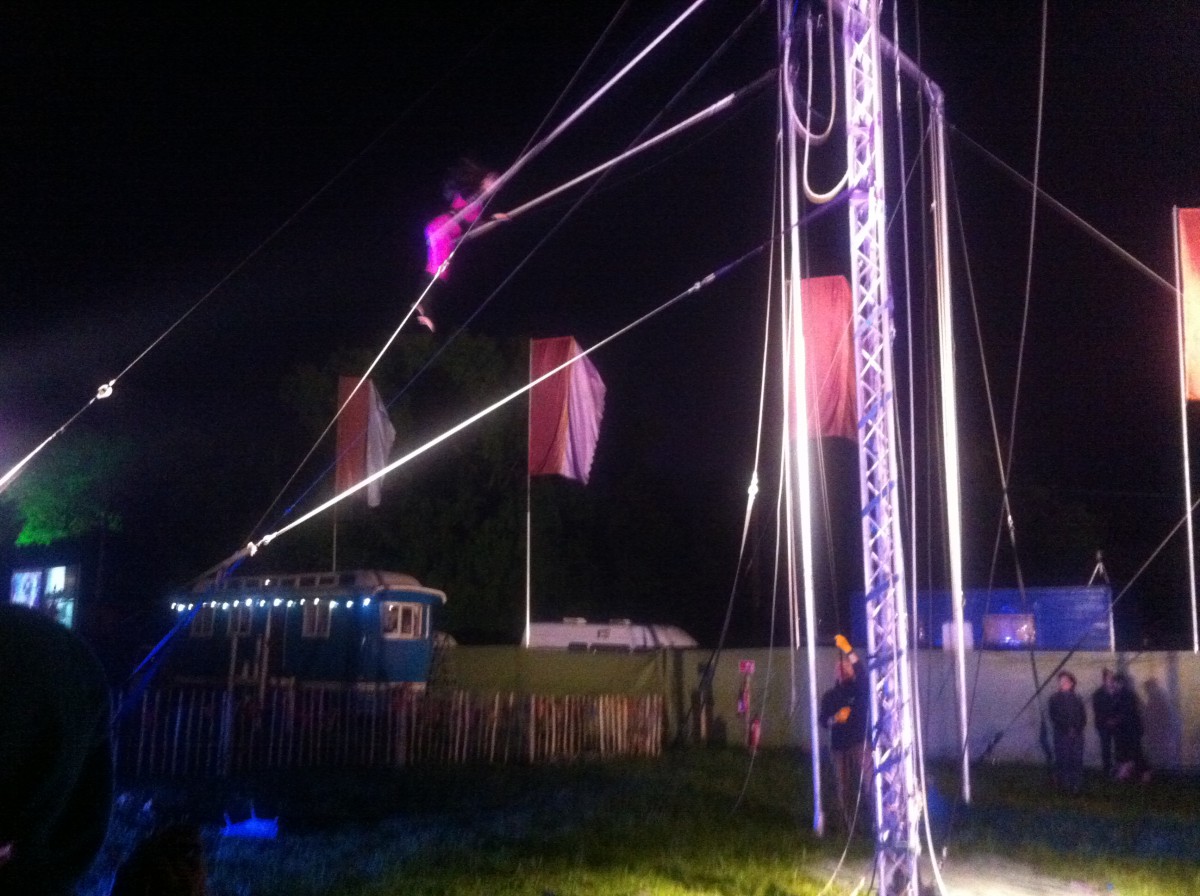Review from: Glastonbury Festival, June 2014

Offering flying trapeze workshops during the day, and illuminated aerial performance by night, the Above and Beyond grand volant cuts an imposing figure over the Glastonbury Circus Field. The company, run by Mike Wright, has been a fixture of the field’s entertainment for almost a decade, and this year I was able to speak with them about their work.
Wright discovered flying trapeze while working as a ballet dancer in his native South Africa, after growing up in Zambia. His first gig in the UK was on Billy Smart’s Circus in 1969 and now, aged 67, he is joint Head of Aerial at Circomedia circus school in Bristol, and still flies with Above and Beyond, as well as working independently as a producer and coach.
This year, Wright has picked up on the ‘infotainment’ trend in current circus performance, and Living On Air, which has been developed specifically for Glastonbury 2014, links its aerial acts together with snippets of narrative that draw upon a loose history of aerial performance.
Above and Beyond strives to create aerial theatre; work that will engage an audience’s brain, rather than presenting tricks alone. ‘Just doing stuff is not enough’, explains Wright, ‘Monkeys do tricks; we do performance’

His team are drawn from the vast network of artists Wright encounters in his own teaching and creative practise and, as well as employing established international performers, the company also serves the important function of a stepping stone into the profession for emerging artists.
On the first night of the festival, I join the gathering crowds around the perimeter of the Above and Below enclosure, enjoying the still summer air and the rawly lit rig. Danny Chase‘s voice is clear over the PA system, announcing a show that will explore the history of aerial performance and a worldwide need to climb, through the three disciplines of rope, static trapeze and swinging trapeze, and three styles of ancient, traditional and contemporary.
The text is composed to challenge our assumptions of each distinction, raising questions about which act fits where amongst the definitions provided. While watching the show I find this confusing but, speaking to Wright afterwards, I can understand that the ambiguity is intentional. ‘It’s difficult to corral or box something in‘, the director explains, ‘These labels don’t mean so much. There’s always good circus and bad circus.‘ It seems that he wants us to re-evaluate our pre-conceived notions of categories, and see the interplay between their elements.

As in the classical circus format, individual acts are presented as separate pieces, with no cohesive aesthetic or theme beyond a stylistic showcase. Among the 18 performers, many are unremarkable or lacklustre tonight. I find the overall concept interesting, but without enough depth in its delivery. What’s disturbing though, are the factual inaccuracies. Jules Léotard’s invention of the flying trapeze was as a solo bar-to-bar routine, and the human catcher was a later development by aerialists who followed. Being told that Léotard pioneered the cradle catch and partner flying really grates on me. (It’s also frustrating that the internet’s copy’n’paste syndrome has provided the online world with hundreds of articles that neglect to mention the exact nature of Léotard’s invention of the form, which no doubt furthers these misconceptions).
The isolation of each act allows us to see each on its own merits, and Milena Lippuner and Hannah Yellak’s doubles trapeze provides good rhythms and a nice repertoire of tricks for such a short act. Larissa Dingler and Sonja Müller-Götte, also on doubles trapeze, present one of the evening’s most memorable numbers, with a real sense of purpose behind their creative use of the equipment and each other. I especially enjoy watching them because they seem to be enjoying themselves, and its satisfying to see the pair continue to play their roles even after dismount.

Colette Orler‘s contortion act – with matching mannequin legs – is fascinating, giving the impression of a one-woman acrobalance. It’s presented on a raised stage, and narrator Chase asks us to consider ‘what makes a performance ‘aerial?” Although I can’t accept that a regular stage at height can fall into the category, I like the provocative questioning.
I enjoy seeing the unusual swinging swivel lyra of Rachel Mayes, and Nils Wollschläger and Julia Knaust’s knee perch, which is used to strong symbolic effect, and is also very interesting within the context of evolving notions of ‘trapeze’.
Wright is proving his worth tonight on the safety lunge for the swinging performers, and is rewarded by a generous cheer when he takes to the fly-bar in the finale .
With a few exceptions, the form tonight has not been top-notch, and re-rig transitions have been dead space, but we have seen a variety of styles to remind us how vast a beast ‘aerial performance’ is, and the spectacle of night-time open-air aerial work is unusual.
In the words of the show itself, ‘Contemporary does not mean uncharted‘ and, through the reviews on this website, I hope to do my part in ensuring the evolution of circus arts continues to leave its traces and trails for the future.
GFCPA



